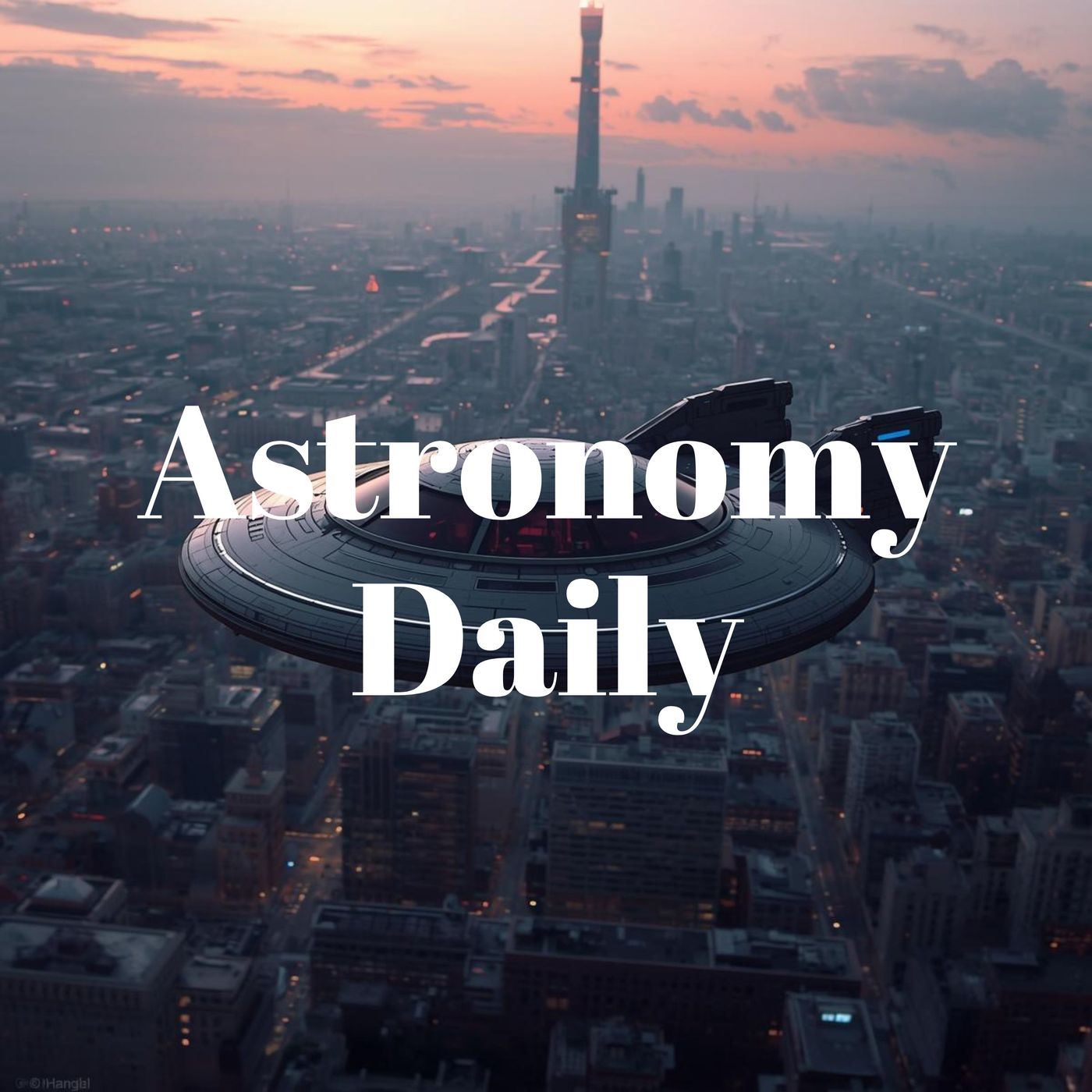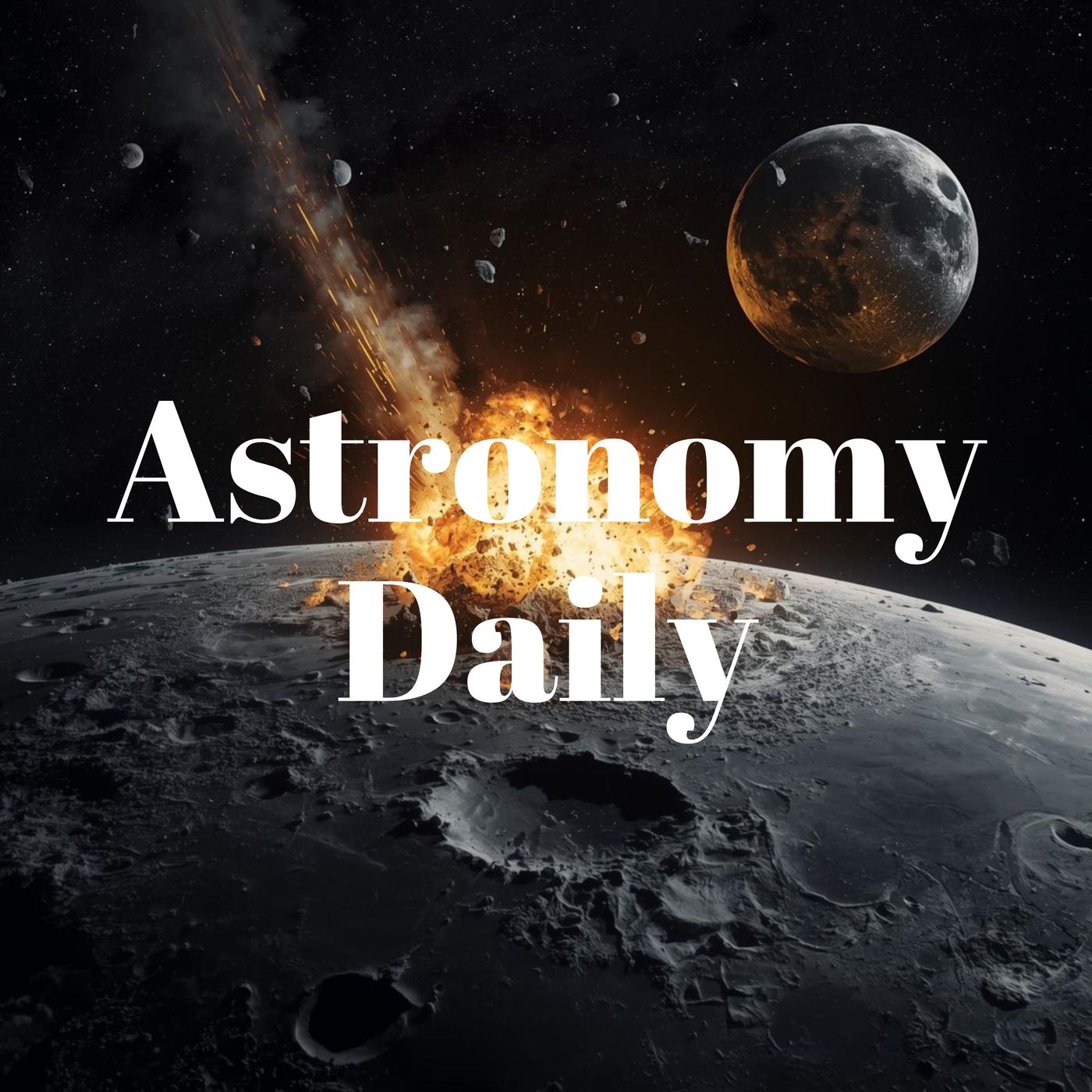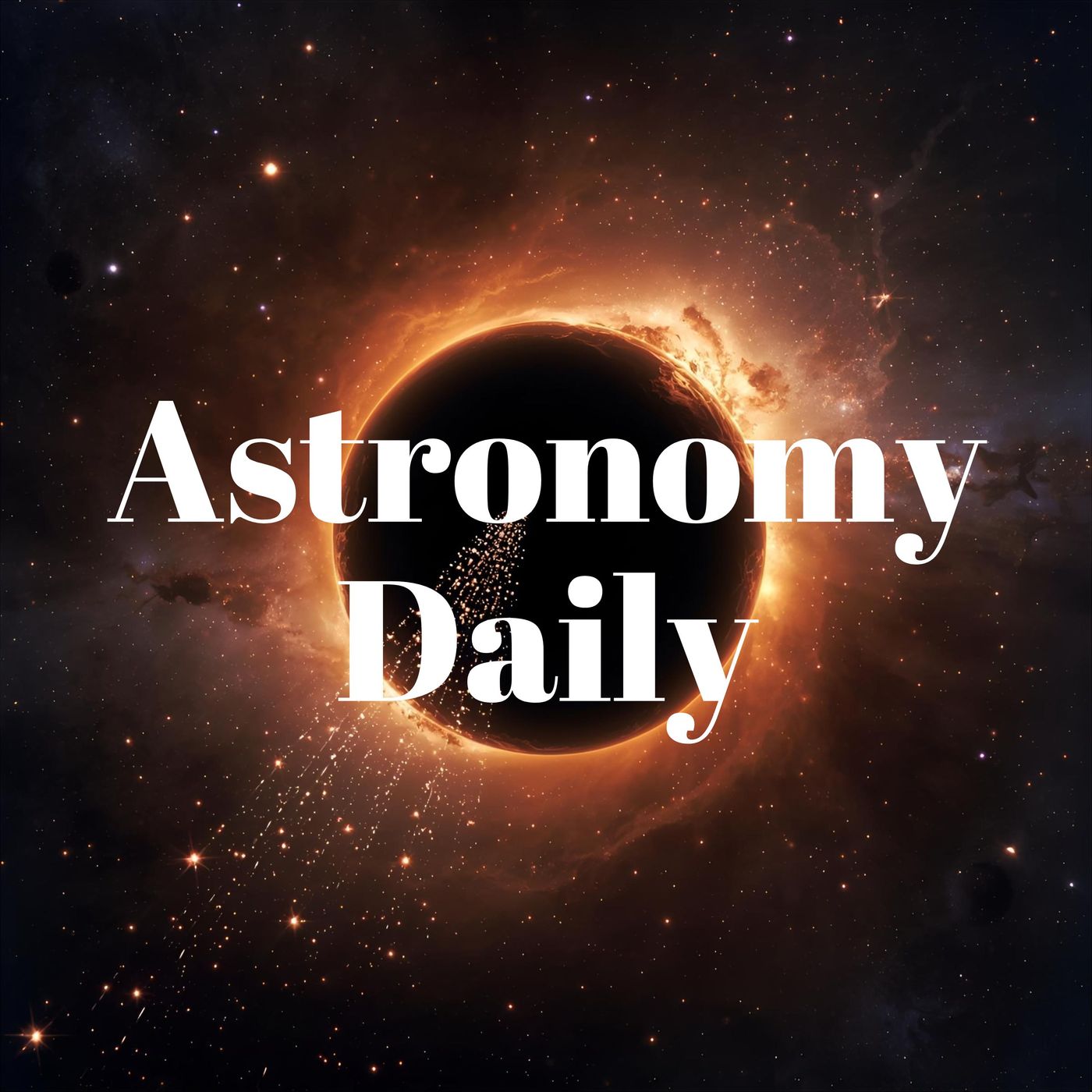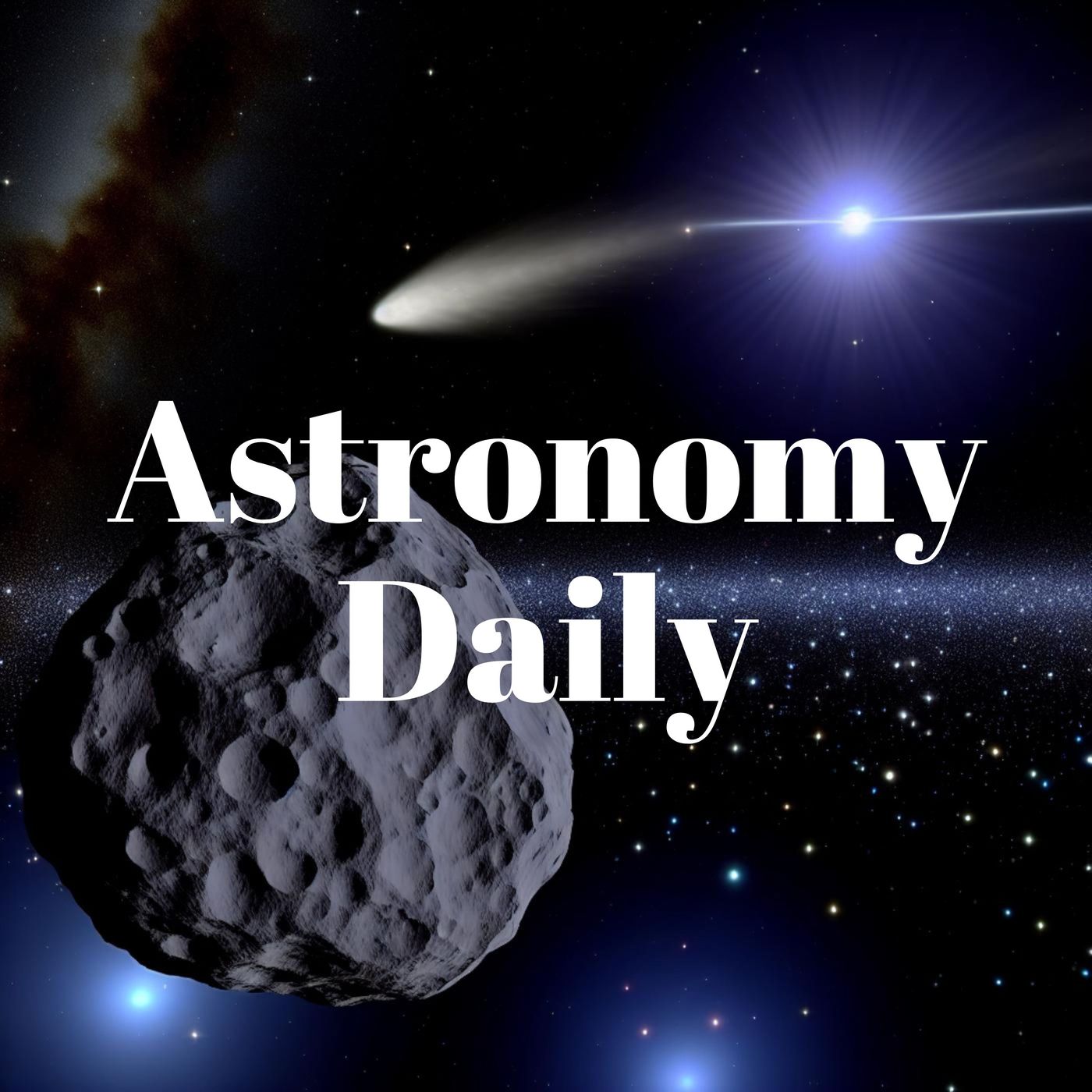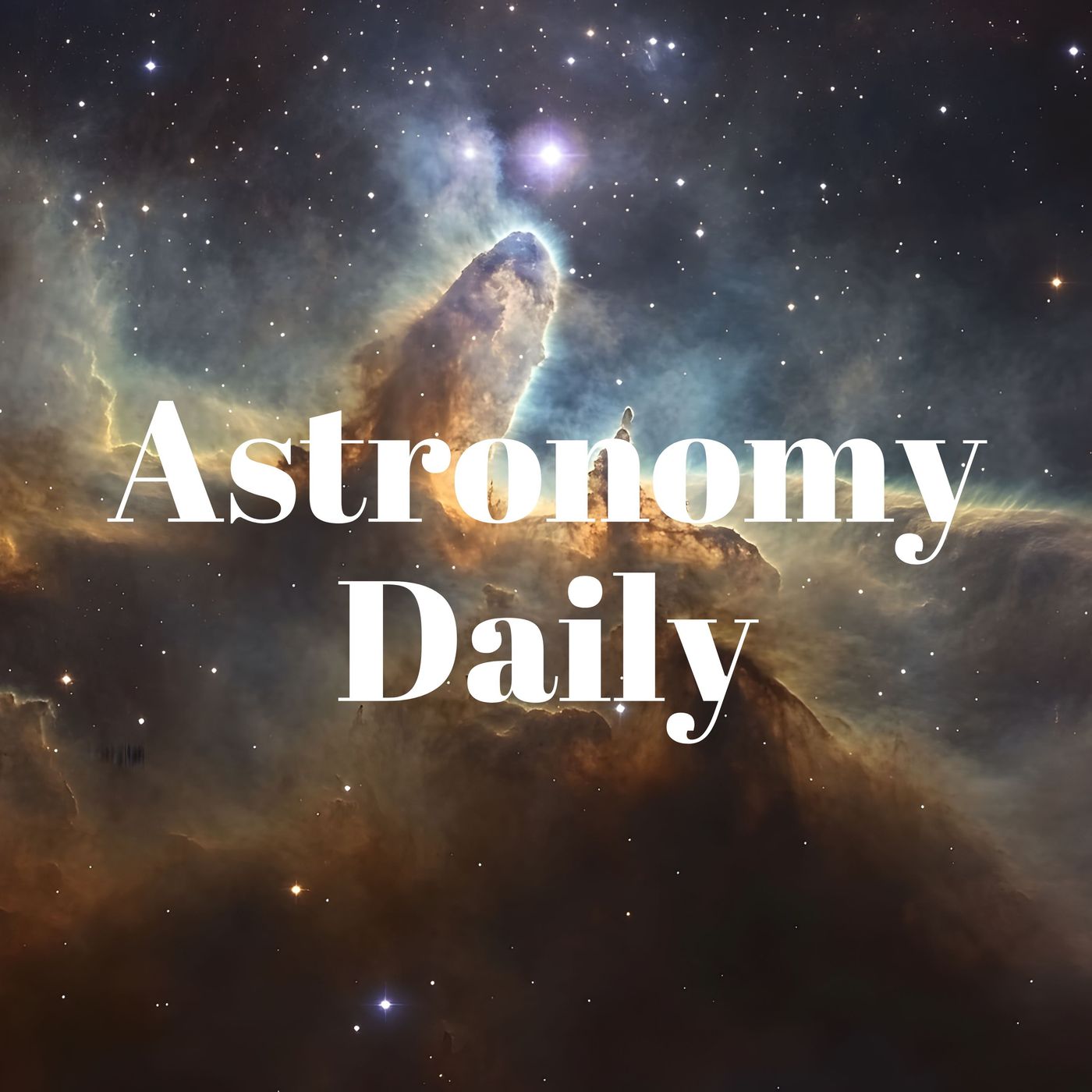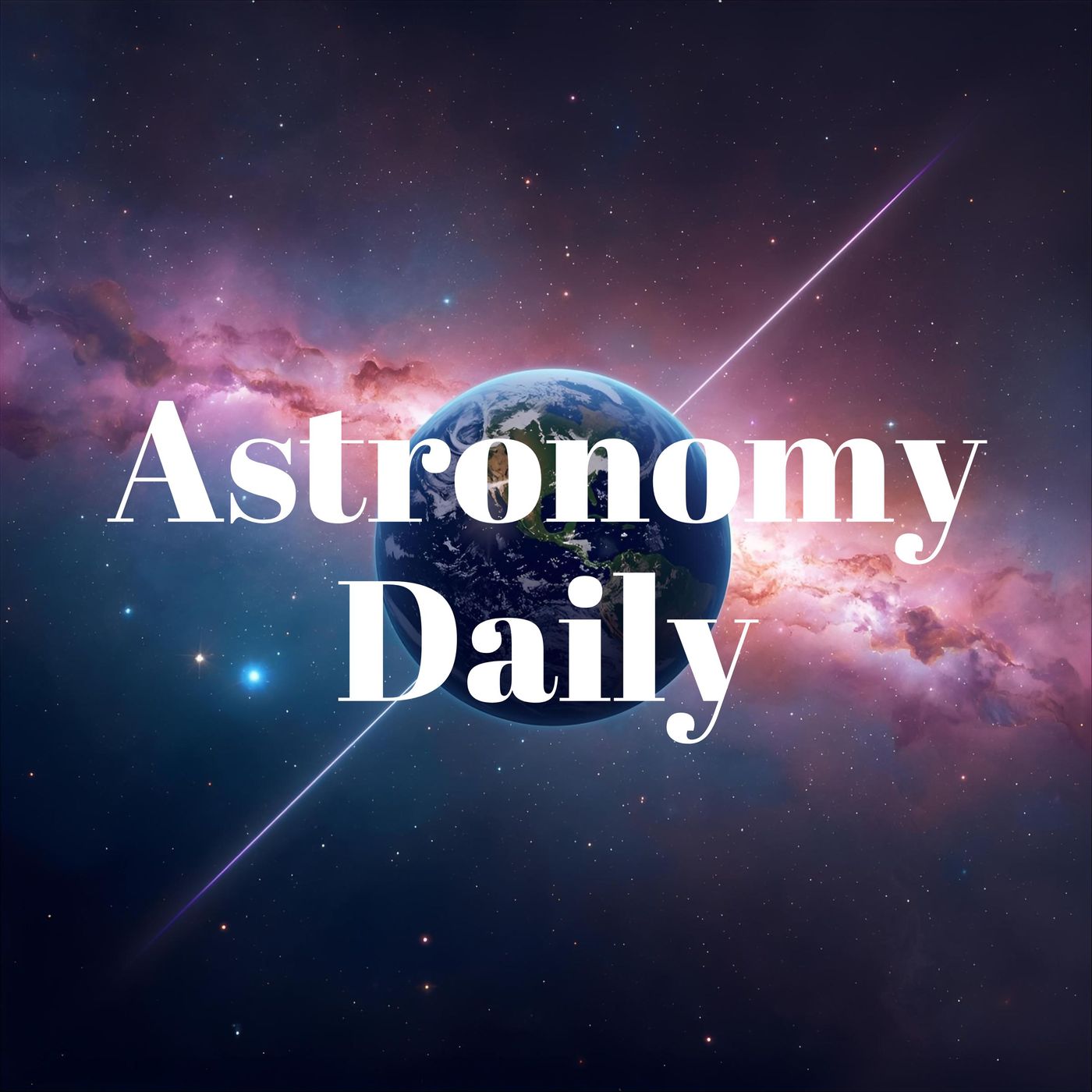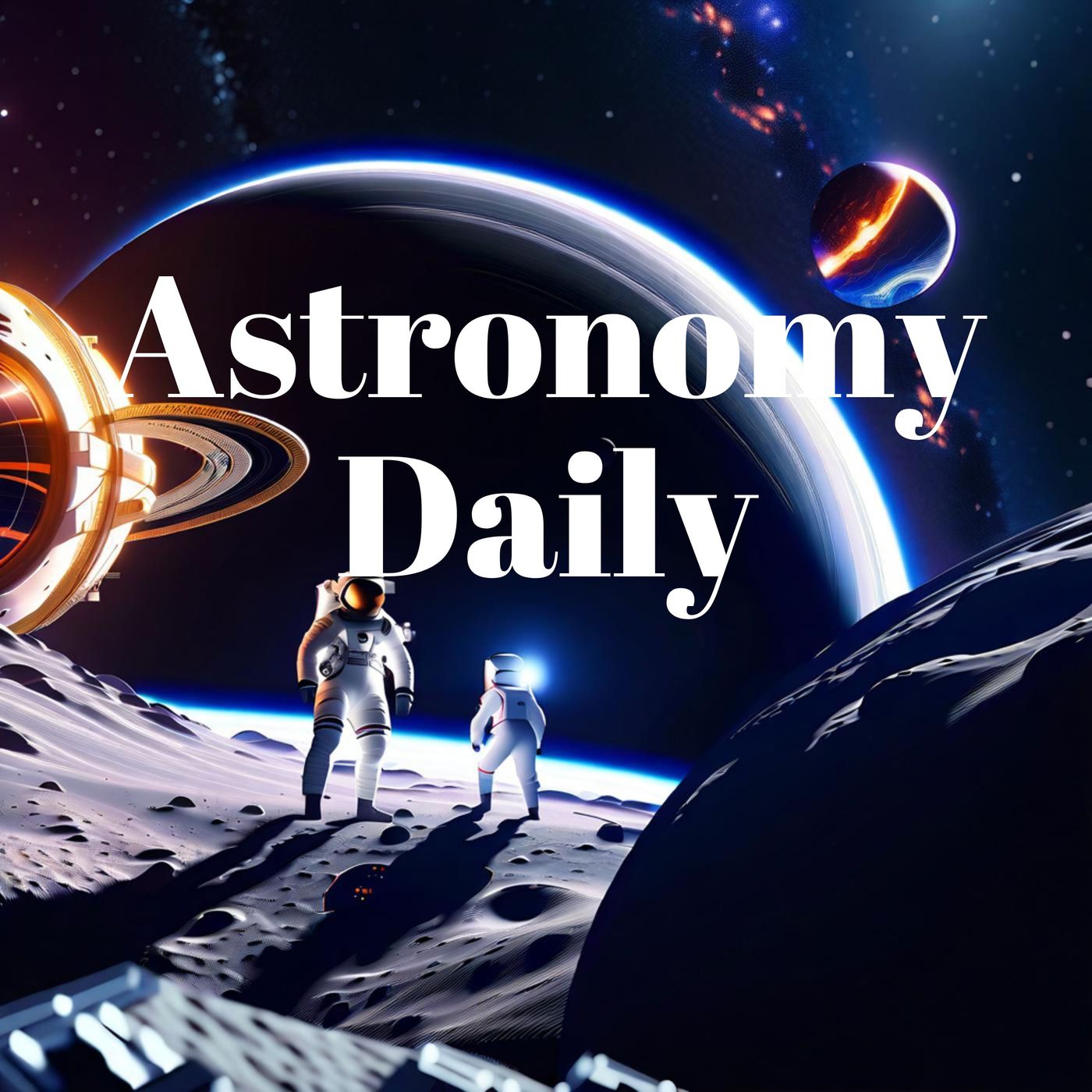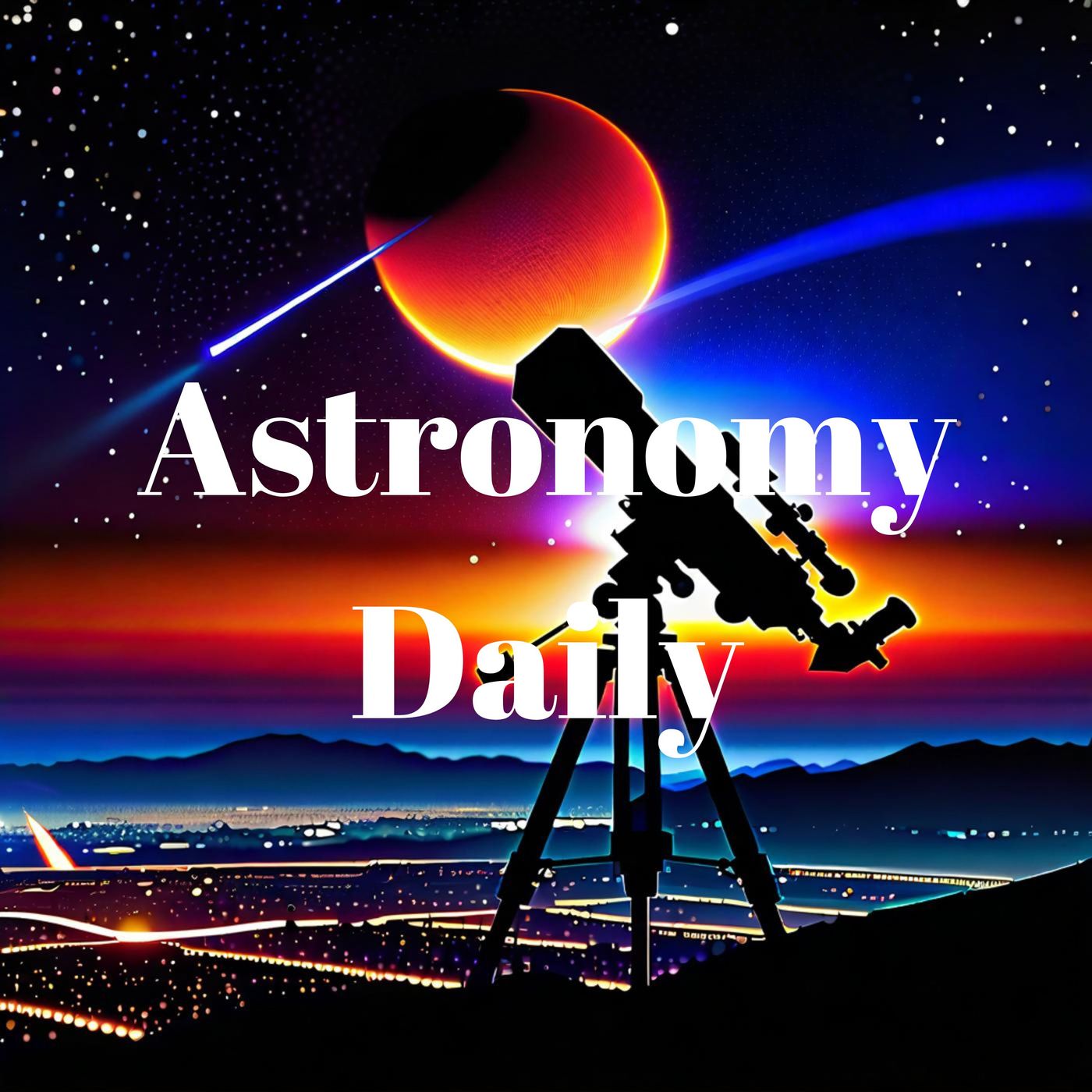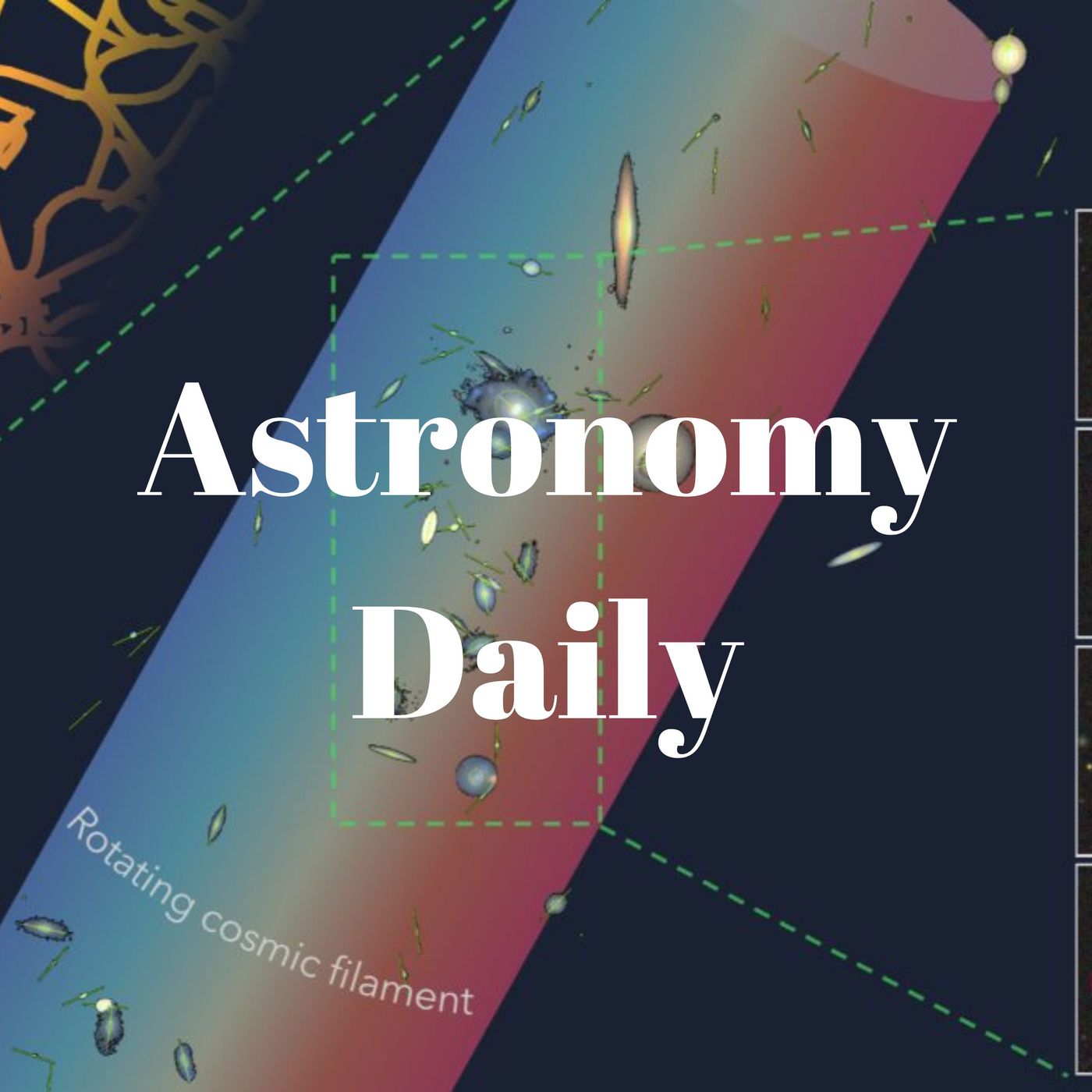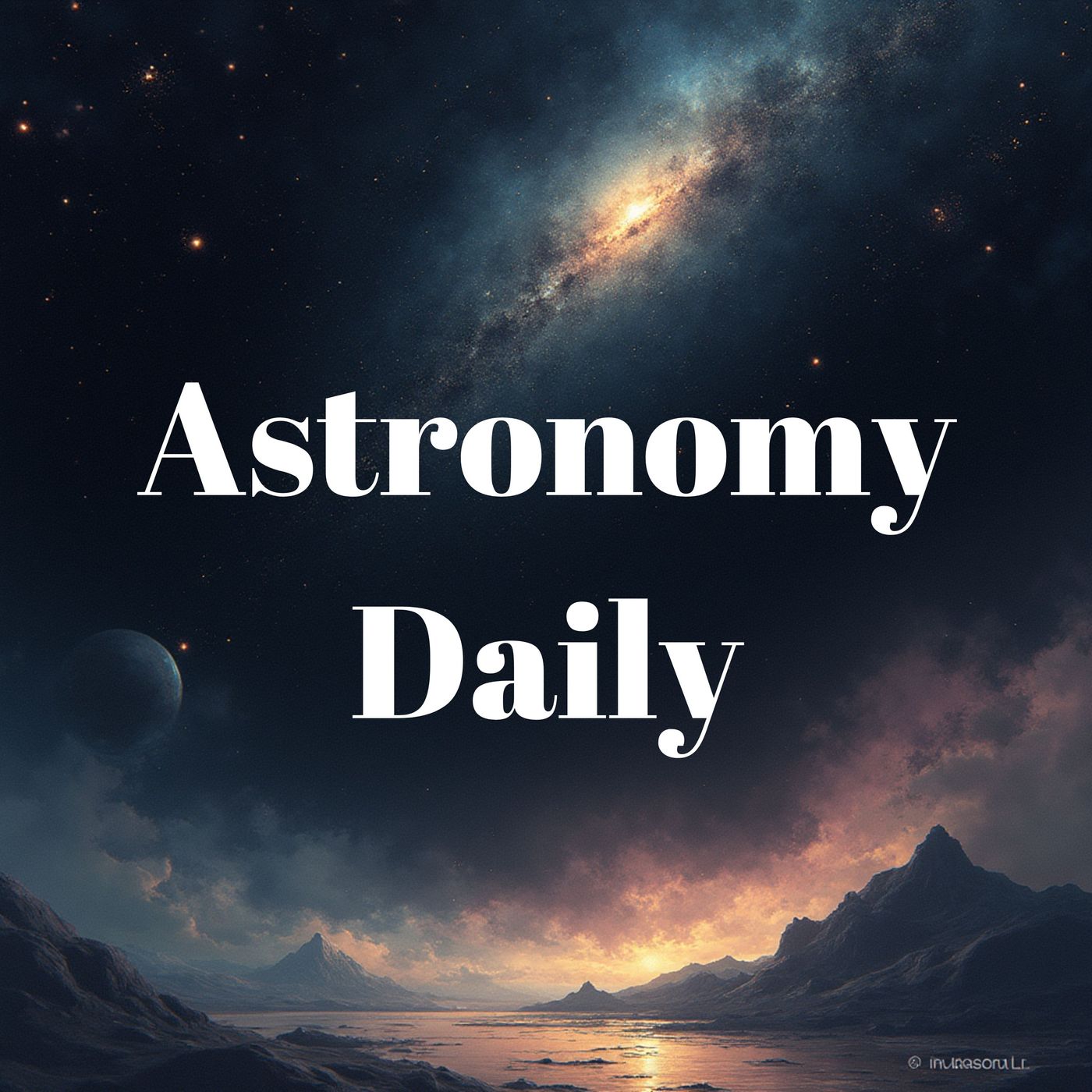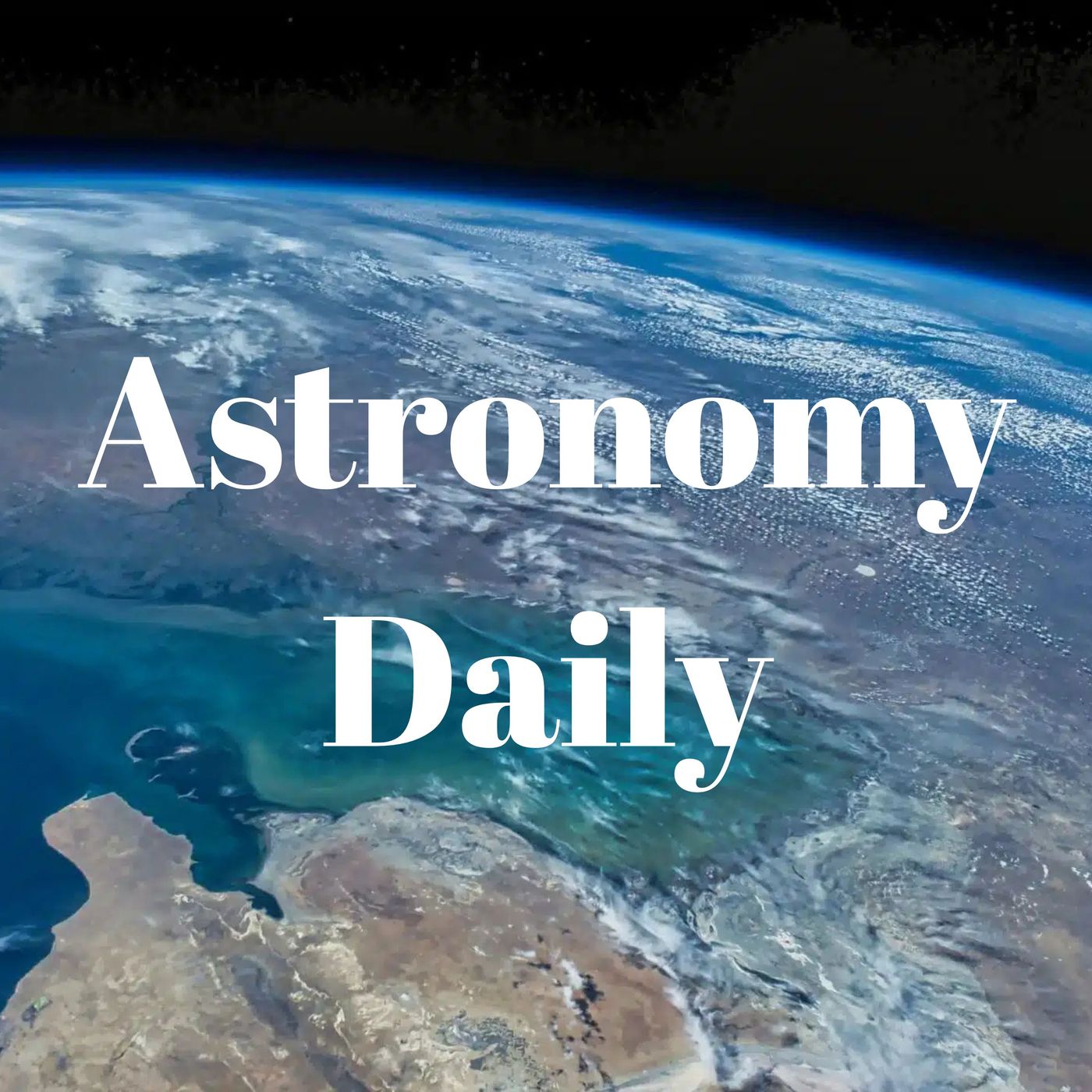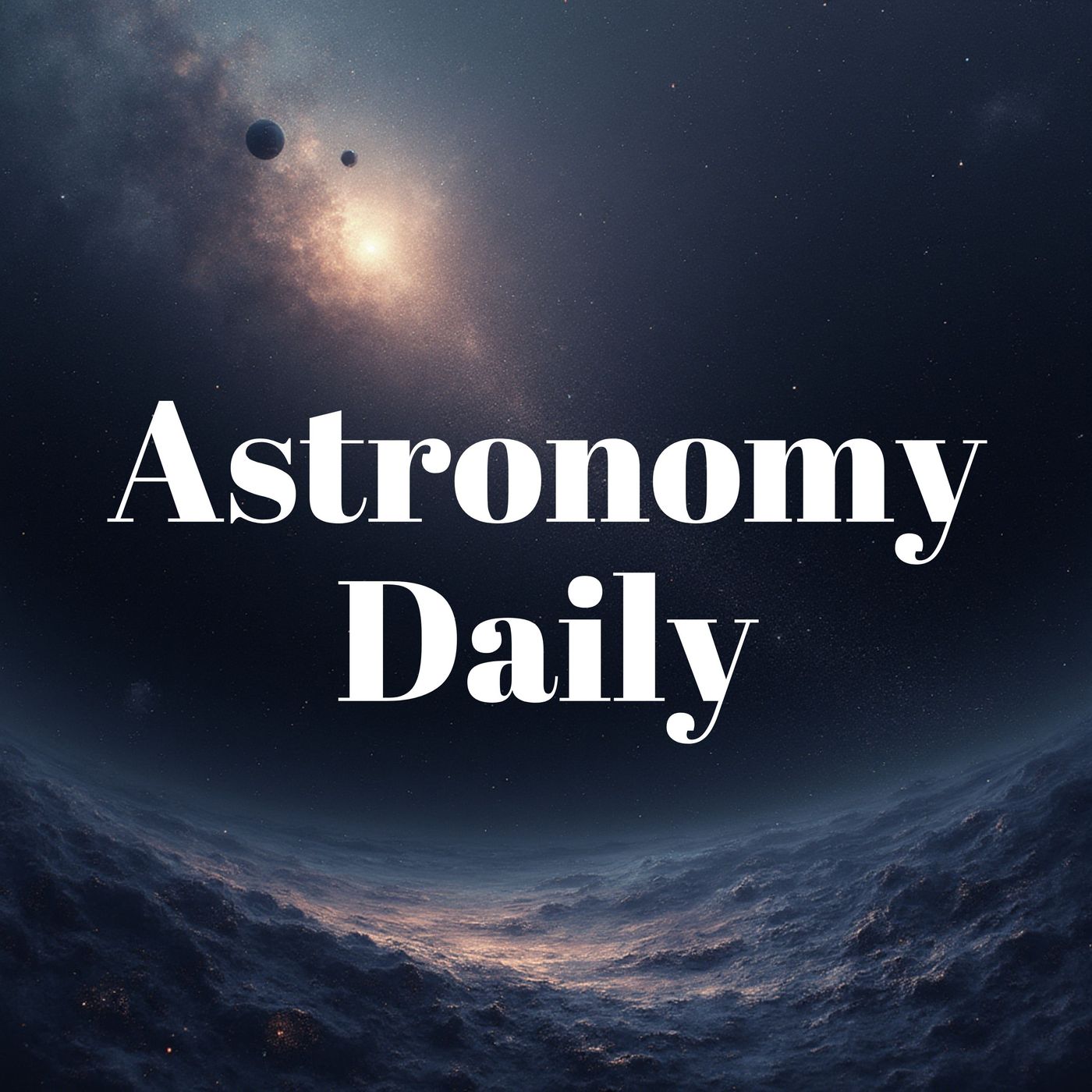Discover Astronomy Daily: Space News Updates
Astronomy Daily: Space News Updates

Astronomy Daily: Space News Updates
Author: bitesz.com
Subscribed: 114Played: 19,672Subscribe
Share
© Copyright bitesz.com
Description
Join hosts Anna & Avery for daily Space & Astronomy news, insights, and discoveries.
Give us 10 minutes and we'll give you the Universe!
For more visit, our website and sign up for the free daily newsletter and check out our continually updated newsfeed. www.astronomydaily.io.
Follow us on X (formerly Twitter), Facebook, YouTube and TikTok ...just search for AstroDailyPod. Enjoy!
Become a supporter of this podcast: https://www.spreaker.com/podcast/astronomy-daily-space-news-updates--5648921/support.
Give us 10 minutes and we'll give you the Universe!
For more visit, our website and sign up for the free daily newsletter and check out our continually updated newsfeed. www.astronomydaily.io.
Follow us on X (formerly Twitter), Facebook, YouTube and TikTok ...just search for AstroDailyPod. Enjoy!
Become a supporter of this podcast: https://www.spreaker.com/podcast/astronomy-daily-space-news-updates--5648921/support.
701 Episodes
Reverse
In this episode, we delve into the latest advancements in UAP research and explore a groundbreaking discovery that suggests our universe might not be as symmetrical as once thought. We begin with the ongoing investigation into unidentified anomalous phenomena (UAPs), where experts emphasize the need for rigorous scientific study and funding to uncover the truth behind these mysterious sightings. As momentum builds, institutions like the University of Wurtzburg and the Galileo Project are stepping up to collect high-quality data on UAPs, with potential national security implications highlighted by former Navy pilot Ryan Graves.Next, we shift our focus to a fascinating cosmological anomaly that challenges the long-held cosmological principle of isotropy. A new study reveals that the cosmic microwave background exhibits temperature variations that suggest our galaxy is moving through space in a preferred direction, raising questions about dark energy and the Big Bang itself.On Mars, NASA's Mars Reconnaissance Orbiter has identified the largest fresh impact crater ever confirmed, providing valuable insights into the planet's active geological processes. This remarkable discovery showcases the ongoing dynamism of our solar system.We then explore a rare cosmic phenomenon involving a triple system of galaxies, each hosting supermassive black holes that are actively feeding. This unprecedented finding enhances our understanding of galaxy evolution and the interactions that drive black hole growth.Finally, we discuss innovative strategies to protect future astronauts from the dangers of cosmic rays during long-duration missions. With insights drawn from biology and the study of resilient organisms, researchers are uncovering potential methods to safeguard human health in the harsh environment of space.Join us as we unpack these captivating stories and more on this episode of Astronomy Daily!00:00 – **Astronomy Daily brings you the latest news from across the cosmos00:37 – **Unidentified anomalous phenomena are still being reported in America's skies02:51 – **New study suggests the universe may not be as symmetrical as we've always thought04:40 – **NASA's Mars Reconnaissance Orbiter has discovered the largest fresh impact crater06:04 – **Astronomers have confirmed first known triple system where all three black holes feed07:40 – **One of the single biggest obstacles for future long duration space missions is cosmic rays09:42 – **This week's Astronomy Daily features a number of interesting topics### Sources & Further Reading1. NASA2. Scientific Coalition for UAP Studies3. HuffPost on UAPs4. Space.com### Follow & ContactX/Twitter: @AstroDailyPodInstagram: @astrodailypodEmail: hello@astronomydaily.ioWebsite: astronomydaily.ioClear skies and see you next time! 🌟Become a supporter of this podcast: Support Us.Sponsor Details:Ensure your online privacy by using NordVPN. To get our special listener deal and save a lot of money, visit www.bitesz.com/nordvpn. You'll be glad you did!Become a supporter of Astronomy Daily by joining our Supporters Club. Commercial free episodes daily are only a click way... Click HereThis episode includes AI-generated content.
In this episode, we explore groundbreaking developments in lunar colonization and the intriguing behaviors of interstellar visitors. We kick off with a bold announcement from Russia, revealing plans to construct a nuclear power plant on the Moon in collaboration with China, aiming for completion by 2036. This ambitious project signifies a shift towards sustainable human presence on the lunar surface. Next, we dive into a sci-fi-inspired innovation as Russia's Energia rocket company patents a spacecraft design featuring artificial gravity, a game-changer for long-duration space missions, potentially mitigating the adverse effects of zero gravity on astronauts.Shifting gears, we celebrate a significant achievement in satellite technology with the launch of Bluebird 6, a record-breaking satellite designed to provide broadband internet directly to smartphones, boasting the largest communication array ever deployed in low Earth orbit. However, not all news is positive, as Japan faces a setback with the failure of its H3 rocket during a critical mission to deliver the Michibiki 5 satellite, crucial for enhancing GPS accuracy in East Asia.Finally, we journey beyond our solar system to investigate the interstellar comet 3I ATLAS, which exhibits unusual behavior, including a rare sun-facing anti-tail and wobbling jets of outgassing material. This discovery provides insights into the comet's rotation, revealing its nucleus spins once every 15.5 hours. Join us as we unpack these fascinating stories and more in this episode of Astronomy Daily!00:00 – **Today we're covering ambitious plans for lunar colonization and fascinating new discoveries00:36 – **Russia plans to build a nuclear power plant on the moon by 203601:49 – **Russian rocket company has just secured a patent for a new spacecraft design03:11 – **Indian rocket recently launched the Bluebird 6 satellite, and it's a record breaker04:27 – **Japan's ambitions for an independent satellite navigation system suffered a significant blow05:31 – **Astronomers studying interstellar comet 3I ATLAS have observed unusual behavior06:59 – **Today's featured news includes ambitious plans for nuclear power on the Moon### Sources & Further Reading1. NASA2. Roscosmos3. Space.com4. AST SpaceMobile5. JAXA### Follow & ContactX/Twitter: @AstroDailyPodInstagram: @astrodailypodEmail: hello@astronomydaily.ioWebsite: astronomydaily.ioClear skies and see you next time! 🌟Become a supporter of this podcast: Support Us.Sponsor Details:Ensure your online privacy by using NordVPN. To get our special listener deal and save a lot of money, visit www.bitesz.com/nordvpn. You'll be glad you did!Sponsor Details:Ensure your online privacy by using NordVPN. To get our special listener deal and save a lot of money, visit www.bitesz.com/nordvpn. You'll be glad you did!Become a supporter of Astronomy Daily by joining our Supporters Club. Commercial free episodes daily are only a click way... Click HereThis episode includes AI-generated content.
In this episode, we navigate through a range of significant stories impacting the space industry today. We begin with a setback for South Korea's Innospace, as their Hanbit Nano rocket tragically crashes just 30 seconds after liftoff from Brazil's Alcantara Space Center. While the company cited a vehicle abnormality, the incident raises questions about the challenges faced by emerging private space firms. Next, we take a fascinating journey back in time to explore a period when Earth's day lasted only 19 hours. New research reveals a unique balance between lunar and solar forces that maintained this rhythm for a billion years, potentially influencing the evolution of early life on our planet. As we shift our focus to the present, we discuss an exciting and busy launch schedule for the end of 2025, featuring missions from China, India, Russia, and SpaceX, highlighting the global nature of the space industry. We also address serious safety concerns surrounding Boeing's Starliner following its first crewed test flight. A NASA advisory panel has criticized the agency for not adequately recognizing the mission's issues, which led to astronauts being stranded on the ISS for nine months. Finally, we report on a major leadership change at United Launch Alliance, with CEO Tory Brian resigning after nearly 12 years, leaving behind a legacy tied to the development of the Vulcan Centaur rocket. Join us as we unpack these stories and more in this episode of Astronomy Daily!00:00 – **Today we'll cover some unfortunate news for South Korea's burgeoning space industry00:31 – **South Korean company Innospace's first commercial orbital rocket crashed in Brazil02:10 – **For about a billion years Earth's day flatlined at 19 hours04:34 – **The last full week of 2025 is shaping up to be incredibly busy for space launches06:18 – **NASA's Aerospace Safety Advisory Panel has come out with a pretty strong statement09:49 – **Tory Bruno, president and CEO of United Launch alliance, has resigned11:06 – **It's been another busy day in astronomy and spaceflight### Sources & Further Reading1. NASA2. SpaceX3. United Launch Alliance4. Innospace5. Space.com### Follow & ContactX/Twitter: @AstroDailyPodInstagram: @astrodailypodEmail: hello@astronomydaily.ioWebsite: astronomydaily.ioClear skies and see you next time! 🌟Become a supporter of this podcast: https://www.spreaker.com/podcast/astronomy-daily-space-news-updates--5648921/support.Sponsor Details:Ensure your online privacy by using NordVPN. To get our special listener deal and save a lot of money, visit www.bitesz.com/nordvpn. You'll be glad you did!Become a supporter of Astronomy Daily by joining our Supporters Club. Commercial free episodes daily are only a click way... Click HereThis episode includes AI-generated content.
In this episode, we celebrate remarkable advancements in space exploration and the intriguing discoveries that challenge our understanding of the universe. We kick off with the inspiring story of Michaela Benthaus, who has made history as the first paraplegic and wheelchair user to fly to space aboard Blue Origin's New Shepard rocket, showcasing the importance of accessibility in space travel. Next, we delve into NASA's groundbreaking PUNCH mission, which is set to provide an unprecedented view of the solar wind, allowing us to track solar phenomena and improve space weather forecasting like never before.Shifting our focus to lunar exploration, we discuss innovative engineering solutions for building reusable launch pads on the Moon using in situ resource utilization. This ambitious project aims to utilize lunar regolith to create durable surfaces, paving the way for sustainable human presence on the Moon.Then, we venture into the depths of space to explore a bizarre lemon-shaped planet, PSR J2322 2652B, orbiting a pulsar. Its unusual carbon-rich atmosphere and oblong shape challenge our current understanding of planetary formation around such extreme celestial objects.Finally, we return to Mars, where NASA's Perseverance rover is examining massive megaripples on the Martian surface, providing insights into the planet's dynamic climate history. Join us as we unpack these fascinating stories and more in this packed episode of Astronomy Daily!00:00 – 00:33 – 01:28 – 03:44 – 06:15 – 08:32 – 09:35 – ### Sources & Further Reading1. NASA2. Blue Origin3. James Webb Space Telescope4. NASA Mars Exploration5. Space.com### Follow & ContactX/Twitter: @AstroDailyPodInstagram: @astrodailypodEmail: hello@astronomydaily.ioWebsite: astronomydaily.ioClear skies and see you next time! 🌟Become a supporter of this podcast: Support Us.Sponsor Details:Ensure your online privacy by using NordVPN. To get our special listener deal and save a lot of money, visit www.bitesz.com/nordvpn. You'll be glad you did!Become a supporter of Astronomy Daily by joining our Supporters Club. Commercial free episodes daily are only a click way... Click HereThis episode includes AI-generated content.
In this episode, we bid farewell to the interstellar comet 3I/Atlas as it completes its closest approach to Earth, offering a glimpse into a cosmic journey that spans billions of years. We discuss the Parker Solar Probe's remarkable 26th close approach to the Sun, where it continues to gather critical data about solar activity at a staggering speed of 430,000 miles per hour. In a more whimsical turn, we share the exciting news of a public contest to design a mascot for NASA's Artemis 2 mission, highlighting the incredible engagement from around the globe.Shifting gears, we delve into the enigma of luminous fast blue optical transients (LFBOTs), exploring a recent discovery that suggests these cosmic explosions may arise from massive black holes tearing apart companion stars. We also examine the potential threat posed by asteroid 2024 YR4, which has a small chance of impacting the Moon in 2032, potentially scattering debris into near-Earth space. Finally, we analyze Russia's revamped plans for its future in space, as it opts to repurpose aging modules from the International Space Station into a new national space station, raising questions about safety and scientific capabilities.### Timestamps & Stories01:05 –Story 1: Farewell to Interstellar Comet 3I/Atlas****Key Facts**- Comet 3I/Atlas made its closest approach to Earth, coming within 168 million miles.- It is only the third interstellar object detected passing through our solar system.03:20 – **Story 2: Parker Solar Probe's Close Approach****Key Facts**- The probe completed its 26th perihelion, flying just 3.8 million miles from the Sun.- It operated autonomously while gathering crucial data about solar activity.05:45 – **Story 3: NASA's Artemis 2 Mascot Contest****Key Facts**- NASA invited the public to design a zero gravity indicator for the Artemis 2 mission.- Thousands of submissions were received, with 25 finalists selected.08:00 – **Story 4: Understanding LFBOTs****Key Facts**- Recent findings suggest LFBOTs result from black holes shredding companion stars.- The energy emitted during these events is significantly higher than typical supernova explosions.10:15 – **Story 5: Potential Impact of Asteroid 2024 YR4****Key Facts**- There is a 4% chance that this building-sized asteroid will hit the Moon in 2032.- The impact could release energy equivalent to 400 times the Hiroshima bomb.12:00 – **Story 6: Russia's Future in Space****Key Facts**- Russia plans to repurpose the old ISS modules into a new national space station.- Concerns arise regarding the safety and maintenance of aging infrastructure.### Sources & Further Reading1. NASA2. James Webb Space Telescope3. Space.com4. European Space Agency5. NASA Solar System Exploration### Follow & ContactX/Twitter: @AstroDailyPodInstagram: @astrodailypodEmail: hello@astronomydaily.ioWebsite: astronomydaily.ioClear skies and see you next time! 🌟Become a supporter of this podcast: https://www.spreaker.com/podcast/astronomy-daily-space-news-updates--5648921/support.Sponsor Details:Ensure your online privacy by using NordVPN. To get our special listener deal and save a lot of money, visit www.bitesz.com/nordvpn. You'll be glad you did!Become a supporter of Astronomy Daily by joining our Supporters Club. Commercial free episodes daily are only a click way... Click HereThis episode includes AI-generated content.
In this episode, we journey through a captivating array of discoveries and cosmic events that challenge our understanding of the universe. We kick off with a surprising revelation about Titan, Saturn's largest moon, where new analysis suggests its interior may be a thick, warm slush rather than a vast ocean, complicating the search for extraterrestrial life. Next, we discuss a recent anomaly involving SpaceX's Starlink satellites that resulted in a satellite breaking apart, raising concerns about space debris and its implications for future missions.Shifting gears, we delve into the implications of President Trump's executive order on national space policy, which aims for a 2028 moon landing and addresses the increasing militarization of space. We then unravel the mystery of Fomalhaut B, once thought to be an exoplanet, but now revealed to be a cloud of debris from a cosmic collision, providing insight into the chaotic processes of planet formation.As we explore the interstellar comet 3I ATLAS making its closest approach to Earth, we highlight the fleeting opportunity for scientists to study this visitor from another solar system. Finally, we celebrate the Spherex Space Telescope's completion of its first all-sky infrared map, which promises to answer fundamental questions about the universe's structure and the origins of life.### Timestamps & Stories01:05 – **Story 1: Surprising Discovery about Titan****Key Facts**- New analysis suggests Titan's interior may be a thick, warm slush instead of a vast ocean.- This alters the prospects for extraterrestrial life.03:20 – **Story 2: SpaceX's Starlink Anomaly****Key Facts**- A Starlink satellite experienced an anomaly, breaking apart and creating debris.- The satellite is expected to deorbit and burn up in the atmosphere soon.05:45 – **Story 3: National Space Policy Changes****Key Facts**- President Trump's executive order aims for a 2028 moon landing and addresses space security.- The order reinforces NASA's Artemis program and emphasizes sustainable lunar presence.08:00 – **Story 4: The Mystery of Fomalhaut B****Key Facts**- Fomalhaut B was revealed to be a cloud of debris from a cosmic collision, not a planet.- This discovery offers a real-time look at planetary system formation.10:15 – **Story 5: Interstellar Comet 3I ATLAS Approaches Earth****Key Facts**- The comet is making its closest approach, providing a rare observational opportunity.- It is too faint for the naked eye but can be tracked online.12:00 – **Story 6: Spherex Telescope's All-Sky Map****Key Facts**- The Spherex Space Telescope has completed its first all-sky infrared map in 102 colors.- This map will help answer questions about the universe's structure and the origins of life.### Sources & Further Reading1. NASA2. SpaceX3. James Webb Space Telescope4. European Space Agency5. Space.com### Follow & ContactX/Twitter: @AstroDailyPodInstagram: @astrodailypodEmail: hello@astronomydaily.ioWebsite: astronomydaily.ioClear skies and see you next time! 🌟Become a supporter of this podcast: Support Us.Sponsor Details:Ensure your online privacy by using NordVPN. To get our special listener deal and save a lot of money, visit www.bitesz.com/nordvpn. You'll be glad you did!Sponsor Details:Ensure your online privacy by using NordVPN. To get our special listener deal and save a lot of money, visit www.bitesz.com/nordvpn. You'll be glad you did!Become a supporter of Astronomy Daily by joining our Supporters Club. Commercial free episodes daily are only a click way... Click HereThis episode includes AI-generated content.
In this episode, we explore a series of groundbreaking developments in space exploration and astronomy. We start with the monumental announcement of Jared Isaacman, the billionaire entrepreneur and astronaut, as the new head of NASA, signaling a potential shift towards more commercially driven missions. Next, we delve into the astonishing discovery of a supermassive black hole racing through intergalactic space, leaving a trail of newborn stars in its wake—an incredible testament to the capabilities of the James Webb Space Telescope. We then turn our attention to Mars, where the Perseverance Rover has traveled nearly 25 miles, uncovering geological treasures that may hold clues to past life on the Red Planet.Moving closer to home, we discuss recent findings from the Lunar Reconnaissance Orbiter that reveal the Moon is not as dormant as once thought, with young geological features indicating ongoing changes. Finally, we celebrate the successful inaugural launch of the Ariane 6 rocket by the European Space Agency, restoring Europe's independent access to space and enhancing its global navigation capabilities.### Timestamps & Stories01:05 – **Story 1: Jared Isaacman Appointed Head of NASA****Key Facts**- Billionaire entrepreneur and astronaut Jared Isaacman takes the helm at NASA.- His leadership may accelerate partnerships with private space companies.03:20 – **Story 2: Runaway Supermassive Black Hole****Key Facts**- Astronomers confirm a supermassive black hole moving at 2.2 million mph, leaving a trail of stars.- The black hole was ejected from its galaxy due to a cosmic collision.05:45 – **Story 3: Perseverance Rover's Milestone on Mars****Key Facts**- The rover has traveled nearly 25 miles and is conducting groundbreaking geological research.- It is analyzing rocks that may have interacted with water, hinting at past life.08:00 – **Story 4: Active Moon Surfaces****Key Facts**- New images reveal young geological features on the Moon, indicating ongoing changes.- These findings challenge previous assumptions about the Moon's inactivity.10:15 – **Story 5: Successful Launch of Ariane 6 Rocket****Key Facts**- The European Space Agency celebrates the successful inaugural launch of the Ariane 6 rocket.- This launch restores Europe's independent access to space and enhances the Galileo satellite system.### Sources & Further Reading1. NASA2. James Webb Space Telescope3. European Space Agency4. NASA Mars Exploration5. Space.com### Follow & ContactX/Twitter: @AstroDailyPodInstagram: @astrodailypodEmail: hello@astronomydaily.ioWebsite: astronomydaily.ioClear skies and see you tomorrow! 🌟Become a supporter of this podcast: https://www.spreaker.com/podcast/astronomy-daily-space-news-updates--5648921/support.Sponsor Details:Ensure your online privacy by using NordVPN. To get our special listener deal and save a lot of money, visit www.bitesz.com/nordvpn. You'll be glad you did!Sponsor Details:Ensure your online privacy by using NordVPN. To get our special listener deal and save a lot of money, visit www.bitesz.com/nordvpn. You'll be glad you did!Become a supporter of Astronomy Daily by joining our Supporters Club. Commercial free episodes daily are only a click way... Click HereThis episode includes AI-generated content.
In this episode, we dive into some thought-provoking topics that could reshape our understanding of the universe. A groundbreaking study introduces the immersion theory, suggesting that Earth-like planets may be far more common than previously believed, thanks to the explosive influence of nearby supernovae. We also explore the Eschtachian hypothesis, which proposes that our first contact with extraterrestrial life might come in the form of a powerful signal from a civilization in distress. Additionally, we highlight an exciting week of record space launches, including China's Long March 12A rocket and South Korea's Hanbit Nano. We celebrate a significant milestone for NASA's Mars Reconnaissance Orbiter, which has captured its 100,000th image, and we wrap up with the announcement of NASA's Orbit Challenge, inviting college students to innovate for future space exploration.### Timestamps & Stories01:05 – **Story 1: Immersion Theory and Earth-like Planets****Key Facts**- A new study suggests rocky planets may be more common due to supernova explosions.- Estimates indicate that 10-50% of sun-like stars could host planetary systems formed under these conditions.03:20 – **Story 2: The Eschtachian Hypothesis****Key Facts**- Proposed by David Kipping, this theory posits that first contact with aliens may come from a civilization in its final phase.- The idea suggests we may receive a powerful signal as a last testament rather than a friendly communication.05:45 – **Story 3: Record-Breaking Week for Space Launches****Key Facts**- Multiple agencies, including SpaceX and China's space program, are set to launch various missions.- Notable launches include the Ariane 6 for Galileo satellites and Blue Origin's crewed flight.08:00 – **Story 4: Mars Reconnaissance Orbiter Milestone****Key Facts**- NASA's MRO has captured its 100,000th image, chosen by a high school student through the HiWish program.- The landmark photo features stunning mesas and dunes in Syrtis Major.10:15 – **Story 5: NASA's Orbit Challenge for Students****Key Facts**- This new competition invites college students to develop solutions for Earth and deep space exploration.- With a prize pool of up to $380,000, registration is open until February 9, 2026.### Sources & Further Reading1. Science Advances2. NASA3. SpaceX4. European Space Agency5. JAXA### Follow & ContactX/Twitter: @AstroDailyPodInstagram: @astrodailypodEmail: hello@astronomydaily.ioWebsite: astronomydaily.ioClear skies and see you tomorrow! 🌟Become a supporter of this podcast: https://www.spreaker.com/podcast/astronomy-daily-space-news-updates--5648921/support.Sponsor Details:Ensure your online privacy by using NordVPN. To get our special listener deal and save a lot of money, visit www.bitesz.com/nordvpn. You'll be glad you did!Sponsor Details:Ensure your online privacy by using NordVPN. To get our special listener deal and save a lot of money, visit www.bitesz.com/nordvpn. You'll be glad you did!Become a supporter of Astronomy Daily by joining our Supporters Club. Commercial free episodes daily are only a click way... Click HereThis episode includes AI-generated content.
In today's episode, we cover a wide array of intriguing updates from the cosmos, including a concerning communication loss with NASA's MAVEN spacecraft at Mars and the implications of its potential silence for ongoing research. We also highlight a successful rendezvous between two private spacecraft, showcasing advancements in autonomous orbital technologies. Additionally, we discuss the upcoming close approach of interstellar comet 3I Atlas, the fascinating discovery of primordial "dinosaur stars" by the James Webb Space Telescope, and the stunning visuals from the recent Gemin meteor shower. Finally, we explore the future of asteroid mining and its potential to revolutionize space exploration and resource sustainability.### Timestamps & Stories 01:05 – **Story 1: MAVEN Spacecraft Communication Loss****Key Facts** - NASA's MAVEN spacecraft has lost communication, with a brief signal indicating unexpected rotation. - MAVEN plays a critical role in studying Mars' atmosphere and relaying communications for surface rovers. 03:20 – **Story 2: Successful Private Spacecraft Rendezvous****Key Facts** - Starfish Space and Impulse Space executed an autonomous rendezvous in Earth orbit, a significant step for satellite servicing. - The project, named Remora, showcases rapid development from concept to execution. 05:45 – **Story 3: Interstellar Comet 3I Atlas Approaches Earth****Key Facts** - The comet is set to make its closest approach on December 19th, providing a rare observational opportunity. - Telescopes like Hubble and ESA's JUICE will be studying its composition. 08:00 – **Story 4: Discovery of Dinosaur Stars****Key Facts** - JWST may have found evidence of massive primordial stars, potentially up to 10,000 times the mass of our Sun. - These stars could explain the rapid formation of supermassive black holes in the early universe. 10:15 – **Story 5: Gemin Meteor Shower Highlights****Key Facts** - The Gemin meteor shower peaked on December 13, showcasing bright meteors from asteroid 3200 Phaethon. - Astrophotographers captured stunning images from around the world. 12:00 – **Story 6: Future of Asteroid Mining****Key Facts** - Research suggests small asteroids could provide essential resources for Moon and Mars missions. - The potential for water extraction and the economic implications of space resource ownership are discussed. ### Sources & Further Reading 1. NASA2. James Webb Space Telescope3. European Space Agency4. Space.com5. Science Daily### Follow & Contact X/Twitter: @AstroDailyPod Instagram: @astrodailypod Email: hello@astronomydaily.io Website: astronomydaily.io Clear skies and see you tomorrow! 🌟Become a supporter of this podcast: https://www.spreaker.com/podcast/astronomy-daily-space-news-updates--5648921/support.Sponsor Details:Ensure your online privacy by using NordVPN. To get our special listener deal and save a lot of money, visit www.bitesz.com/nordvpn. You'll be glad you did!Become a supporter of Astronomy Daily by joining our Supporters Club. Commercial free episodes daily are only a click way... Click HereThis episode includes AI-generated content.
In today's episode, we delve into a series of captivating stories from the cosmos, including Google's ambitious Project Suncatcher, which aims to build data centers in space, harnessing solar power and the cold vacuum of space for efficiency. We also discuss a close encounter between a Chinese spacecraft and a SpaceX Starlink satellite, highlighting the urgent need for better space traffic management. Additionally, we explore a new theory suggesting that a rogue planet may have reshaped our solar system, and how Mars has been subtly influencing Earth's climate over millennia. To cap it off, we celebrate a remarkable milestone for Voyager 1, as it approaches a staggering distance of one light day from Earth.### Timestamps & Stories 01:05 – **Story 1: Google's Project Suncatcher - Data Centers in Space****Key Facts** - Google plans to launch prototype satellites in 2027 to create an orbital data center powered by solar energy. - The project aims to address the immense energy consumption of data centers on Earth. 03:20 – **Story 2: Close Encounter in Orbit****Key Facts** - A Chinese spacecraft narrowly avoided a collision with a SpaceX Starlink satellite, coming within 200 meters. - The incident underscores the growing problem of space congestion and the need for better coordination among satellite operators. 05:45 – **Story 3: Richie Planet Theory Reshaping Solar System****Key Facts** - New research suggests a rogue planet may have triggered the rearrangement of our solar system's giant planets. - Simulations indicate that a massive object could have caused the instability that shaped the orbits of Jupiter, Saturn, Uranus, and Neptune. 08:00 – **Story 4: Mars' Influence on Earth's Climate****Key Facts** - A study finds that gravitational interactions between Earth and Mars amplify long-term climate cycles on Earth. - These interactions may enhance the effects of Milankovitch cycles, influencing ice ages over millions of years. 10:15 – **Story 5: Voyager 1's Milestone Journey****Key Facts** - Voyager 1 is set to reach a distance of one light day from Earth by November 2026, making communication a 48-hour round trip. - Launched in 1977, it remains the most distant human-made object, continuing to send valuable data from interstellar space. ### Sources & Further Reading 1. Google2. SpaceX3. NASA Voyager Mission4. NASA Solar System Exploration5. European Space Agency### Follow & Contact X/Twitter: @AstroDailyPod Instagram: @astrodailypod Email: hello@astronomydaily.io Website: astronomydaily.io Clear skies and see you tomorrow! 🌟Become a supporter of this podcast: https://www.spreaker.com/podcast/astronomy-daily-space-news-updates--5648921/support.Sponsor Details:Ensure your online privacy by using NordVPN. To get our special listener deal and save a lot of money, visit www.bitesz.com/nordvpn. You'll be glad you did!Sponsor Details:Ensure your online privacy by using NordVPN. To get our special listener deal and save a lot of money, visit www.bitesz.com/nordvpn. You'll be glad you did!Become a supporter of Astronomy Daily by joining our Supporters Club. Commercial free episodes daily are only a click way... Click HereThis episode includes AI-generated content.
Episode Summary In today's episode, we explore a myriad of fascinating developments in space science, ranging from a groundbreaking new galactic map created by NASA's Nancy Chris Roman Space Telescope to innovative color-changing spacesuits designed to protect astronauts from radiation. We also discuss how Earth's magnetosphere may be enriching the Moon's soil with vital resources, a busy month for the International Space Station, and SpaceX's potential plans for an IPO. Finally, we take a closer look at Comet 3i ATLAS, which has been observed glowing in X-ray light, providing new insights into its composition and origins.### Timestamps & Stories 01:05 – **Story 1: New Galactic Map from NASA's Roman Telescope****Key Facts** - NASA's new survey aims to create an unprecedented infrared map of the Milky Way, revealing tens of billions of stars. - The Roman telescope will utilize microlensing techniques to study stellar formation and hidden galactic structures. 03:30 – **Story 2: Color-Changing Spacesuits for Radiation Detection****Key Facts** - Scientists in Scotland are developing spacesuits with bacteria that change color in response to radiation exposure. - This innovation aims to provide real-time monitoring of astronauts' radiation levels during missions. 05:45 – **Story 3: Earth's Magnetosphere Enriching the Moon****Key Facts** - A study suggests that Earth's magnetic field may have seeded the Moon with vital resources like water and nitrogen over billions of years. - This finding could enhance the Moon's potential for future human exploration and habitation. 08:00 – **Story 4: Busy Month for the International Space Station****Key Facts** - The ISS celebrated 25 years of continuous human presence in space and had all eight docking ports occupied for the first time. - The crew conducted various scientific experiments and welcomed new crew members via Soyuz MS.28. 10:15 – **Story 5: SpaceX's Potential IPO****Key Facts** - Speculation arises around SpaceX considering an IPO valued at approximately $1.5 trillion to support ambitious projects like space-based data centers. - This move could pave the way for future Moon factories and advanced AI infrastructure. 12:00 – **Story 6: Comet 3i ATLAS Observed in X-rays****Key Facts** - The European Space Agency's XMM-Newton Observatory captured images of the interstellar comet 3i ATLAS emitting X-rays through charge exchange processes. - This observation provides insights into the comet's composition and its distant stellar origins. ### Sources & Further Reading 1. NASA2. European Space Agency3. University of Rochester4. SpaceX5. International Space Station### Follow & Contact X/Twitter: @AstroDailyPod Instagram: @astrodailypod Email: hello@astronomydaily.io Website: astronomydaily.io Clear skies and see you tomorrow! 🌟Become a supporter of this podcast: https://www.spreaker.com/podcast/astronomy-daily-space-news-updates--5648921/support.Sponsor Details:Ensure your online privacy by using NordVPN. To get our special listener deal and save a lot of money, visit www.bitesz.com/nordvpn. You'll be glad you did!Sponsor Details:Ensure your online privacy by using NordVPN. To get our special listener deal and save a lot of money, visit www.bitesz.com/nordvpn. You'll be glad you did!Become a supporter of Astronomy Daily by joining our Supporters Club. Commercial free episodes daily are only a click way... Click HereThis episode includes AI-generated content.
### Episode Summary Today’s episode features groundbreaking developments in space exploration, including the historic journey of Michaela Benthouse, the first wheelchair user set to fly to space aboard Blue Origin's NS37 mission. We also delve into a major survey of the Magellanic Clouds, revealing insights into their interaction with our Milky Way. Additionally, we discuss surprising findings from NASA's Parker Solar Probe regarding solar recycling, the new race for lunar resources, and the upcoming celestial fireworks from the binary star system V Sagittae. Finally, we explore the innovative Ristretto instrument aimed at studying Proxima B, our nearest exoplanet neighbor.### Timestamps & Stories 01:05 – **Story 1: Michaela Benthouse to Become First Wheelchair User in Space****Key Facts** - Michaela Benthouse, an aerospace engineer, will fly on Blue Origin's NS37 mission, marking a milestone for accessibility in space. - The mission emphasizes the importance of inclusivity in space exploration. 03:20 – **Story 2: Major Survey of the Magellanic Clouds****Key Facts** - A new five-year survey using the VISTA telescope will utilize spectroscopy to create a detailed 3D map of the Magellanic Clouds. - This data will help understand their interaction with the Milky Way and the dynamics of the Magellanic Stream. 05:45 – **Story 3: Surprising Findings from Parker Solar Probe****Key Facts** - The probe captured footage of coronal mass ejections showing material recycling back to the sun. - This discovery could enhance our understanding of solar activity and improve space weather predictions. 08:00 – **Story 4: New Space Race for Lunar Resources****Key Facts** - Nations and companies are developing technologies to mine the Moon for valuable resources like water ice and helium-3. - Concerns arise regarding environmental impacts and the need for updated space treaties. 10:15 – **Story 5: Upcoming Nova from V Sagittae****Key Facts** - The binary star system V Sagittae is predicted to undergo a nova explosion in the coming years, followed by a supernova event. - This celestial display may be visible to the naked eye, potentially occurring around 2083. 12:00 – **Story 6: Ristretto Instrument to Study Proxima B****Key Facts** - Ristretto, a new spectrograph, aims to analyze the atmosphere of Proxima B, our closest exoplanet. - It will use advanced techniques to block out the star's glare and search for potential biosignatures in the planet's atmosphere. ### Sources & Further Reading 1. Blue Origin2. European Southern Observatory3. NASA Parker Solar Probe4. Lunar Mining Developments5. Very Large Telescope### Follow & Contact X/Twitter: @AstroDailyPod Instagram: @astrodailypod Email: hello@astronomydaily.io Website: astronomydaily.io Clear skies and see you tomorrow! 🌟Become a supporter of this podcast: https://www.spreaker.com/podcast/astronomy-daily-space-news-updates--5648921/support.Sponsor Details:Ensure your online privacy by using NordVPN. To get our special listener deal and save a lot of money, visit www.bitesz.com/nordvpn. You'll be glad you did!Become a supporter of Astronomy Daily by joining our Supporters Club. Commercial free episodes daily are only a click way... Click HereThis episode includes AI-generated content.
Episode Summary Today’s episode dives into a whirlwind of cosmic news, featuring a communications hiccup with NASA's MAVEN orbiter at Mars, the astonishing discovery of Earth's magnetic tail, and the unveiling of NASA's new Rover Operations Center. We also explore the intriguing hints of a methane-rich atmosphere on an exoplanet detected by the James Webb Space Telescope, a groundbreaking dual-mode drone from China, and Rocket Lab's innovative "Hungry Hippo" fairing design for their upcoming neutron rocket.### Timestamps & Stories 01:05 – **Story 1: MAVEN Orbiter Loses Contact with Earth****Key Facts** - NASA's MAVEN orbiter has temporarily lost communication, crucial for relaying data from Mars rovers. - The team is working to reestablish contact with the spacecraft. 03:15 – **Story 2: Earth Has a Magnetic Tail****Key Facts** - A NASA study reveals Earth’s magnetotail stretches 2 million kilometers into space, formed by solar wind interaction. - Understanding this structure helps predict space weather impacts on technology. 05:00 – **Story 3: New Rover Operations Center at NASA****Key Facts** - NASA opens the Rover Operations Center to support future lunar and Martian missions. - The center integrates advanced AI and emphasizes partnerships with commercial space companies. 07:30 – **Story 4: James Webb Telescope’s Potential Discovery****Key Facts** - JWST observes the Trappist 1 system, hinting at a methane-rich atmosphere on Trappist 1 e. - The findings are preliminary, and further observations are planned to clarify the signal. 09:10 – **Story 5: China’s Dual-Mode Mars Drone****Key Facts** - A new drone concept combines flying and rolling capabilities to enhance Mars exploration efficiency. - The design aims to conserve energy while allowing exploration of hard-to-reach areas. 11:00 – **Story 6: Rocket Lab’s Hungry Hippo Fairing****Key Facts** - Rocket Lab’s neutron rocket features a unique fairing design that opens like a “Hungry Hippo” to release payloads. - This innovation streamlines the recovery process, contributing to rapid reusability in space launches. ### Sources & Further Reading 1. NASA2. European Space Agency3. James Webb Space Telescope4. Rocket Lab5. Mars Exploration Program### Follow & Contact X/Twitter: @AstroDailyPod Instagram: @astrodailypod Email: hello@astronomydaily.io Website: astronomydaily.io Clear skies and see you tomorrow! 🌟Become a supporter of this podcast: https://www.spreaker.com/podcast/astronomy-daily-space-news-updates--5648921/support.Sponsor Details:Ensure your online privacy by using NordVPN. To get our special listener deal and save a lot of money, visit www.bitesz.com/nordvpn. You'll be glad you did!Become a supporter of Astronomy Daily by joining our Supporters Club. Commercial free episodes daily are only a click way... Click HereThis episode includes AI-generated content.
### Episode Summary A thrilling spacewalk at the Tiangong Space Station, the discovery of the oldest supernova witnessed by the James Webb Telescope, and new insights into the chaotic nature of Super Jupiters highlight today's episode. We also explore the powerful winds generated by a supermassive black hole, showcasing the dynamic interactions in our universe.### Timestamps & Stories 01:05 – **Story 1: Marathon Spacewalk at Tiangong Space Station****Key Facts** - Two astronauts from the Shenshou 21 mission conducted an 8-hour spacewalk to inspect damage on the Shenshou 20 return capsule, struck by space debris. - Installation of new debris protection systems highlights the growing threat of space junk. 03:40 – **Story 2: Record Launches by China****Key Facts** - China set a national record with three Long March rocket launches in under 19 hours. - Missions included broadband satellite deployments and classified military satellites. 05:20 – **Story 3: Bold Recommendations for Mars Exploration****Key Facts** - A new report emphasizes the search for life as the top priority for crewed Mars missions. - Proposed campaigns focus on glacier ice and deep subsurface exploration for biosignatures. 07:00 – **Story 4: Oldest Supernova Detected by JWST****Key Facts** - James Webb Telescope identifies a supernova from 13 billion years ago, just 730 million years post-Big Bang. - This discovery provides insights into the early universe and the lifecycle of massive stars. 08:40 – **Story 5: Super Jupiters Challenge Our Understanding****Key Facts** - Research on exoplanet VHS 1256 b reveals a chaotic atmosphere, differing significantly from Jupiter's stability. - The study suggests massive gas giants may exhibit turbulent weather patterns instead of organized bands. 10:15 – **Story 6: Winds from a Supermassive Black Hole****Key Facts** - A supermassive black hole in galaxy NGC 3783 emits powerful winds at 1/5 the speed of light, impacting galaxy evolution. - Observations from XMM-Newton and XRISM telescopes reveal the connection between black holes and their host galaxies. ### Sources & Further Reading 1. NASA2. European Space Agency3. James Webb Space Telescope4. Mars Exploration Program5. NASA Black Hole Research### Follow & Contact X/Twitter: @AstroDailyPod Instagram: @astrodailypod Email: hello@astronomydaily.io Website: astronomydaily.io Clear skies and see you tomorrow! 🌟Become a supporter of this podcast: https://www.spreaker.com/podcast/astronomy-daily-space-news-updates--5648921/support.Sponsor Details:Ensure your online privacy by using NordVPN. To get our special listener deal and save a lot of money, visit www.bitesz.com/nordvpn. You'll be glad you did!Sponsor Details:Ensure your online privacy by using NordVPN. To get our special listener deal and save a lot of money, visit www.bitesz.com/nordvpn. You'll be glad you did!Become a supporter of Astronomy Daily by joining our Supporters Club. Commercial free episodes daily are only a click way... Click HereThis episode includes AI-generated content.
### Episode Summary Real-time images of exploding stars, a surprisingly “gentle” supermassive black hole, the return of a long-duration Soyuz crew, a packed week of launches, Subaru’s first new exoplanet and brown-dwarf finds, and a controversial plan to light up the night sky with orbital mirrors.### Timestamps & Stories 00:00 – Cold Open 00:35 – Intro 01:05 – **Story 1: Astronomers watch novae explode in real time** **Key Facts** - First-ever direct imaging of two novae as they erupted using the CHARA optical interferometer - V1674 Herculis: fastest nova on record; brightened & faded in days; showed two perpendicular gas jets - V1405 Cassiopeiae: visible to naked eye for months; delayed ejection after 50+ days - Gamma-ray bursts from Fermi telescope timed perfectly with visible jets 03:35 – **Story 2: Soyuz MS-27 crew lands after 8-month ISS mission** **Key Facts** - Crew of three returned safely to Kazakhstan on 8 Dec 2025 - 260+ days in orbit (launched April 2025) - Handover completed; ISS now at full Expedition strength for next rotation 05:05 – **Story 3: Launch Roundup (8–15 Dec 2025)** **Key Facts** - SpaceX Starship Flight 6 (Texas) – major reusability test - China Long March 7A – new Tiangong station module - ULA Vulcan Centaur Cert-2 (Cape Canaveral) – second certification flight - Rocket Lab Electron (New Zealand) – successful dawn launch - Russia Soyuz-2.1b (Vostochny) – classified payload 06:35 – **Story 4: Subaru Telescope’s first discoveries** **Key Facts** - First science results from upgraded high-contrast infrared instruments - New brown dwarf (13–80 Jupiter masses) with dusty disk - New wide-orbit gas-giant exoplanet ~300 light-years away showing methane & water signatures 08:05 – **Story 5: Sagittarius A* is less destructive than thought** **Key Facts** - Objects like G2/DSO, D9, X3, X7 all survive stable orbits within 0.8 parsecs of the 4-million-solar-mass black hole - 20+ years of VLT data (SINFONI, NACO, ERIS) show no tidal disruption - Galactic Center may be a star-formation zone rather than a shredder 09:55 – **Story 6: Giant space mirrors to light up the night** **Key Facts** - Reflect Orbital plans thousands of mirror satellites by 2030 - Each beam ~5 km wide, 4× brighter than full moon - Goal: extend solar-farm output after sunset & aid night rescues - Astronomers warn of catastrophic light-pollution increase and wildlife disruption 11:20 – Outro ### Sources & Further Reading 1. https://connectsci.au/news/news-parent/7462/Astronomers-watch-stars-explode-in-real-time-and 2. https://www.nasa.gov/blogs/spacestation/2025/12/09/soyuz-crew-lands-ending-eight-month-space-research-journey/ 3. https://www.nasaspaceflight.com/2025/12/launch-roundup-120825/ 4. https://www.space.com/astronomy/exoplanets/the-subaru-telescope-just-made-its-1st-discoveries-a-failed-star-and-an-exoplanet 5. https://www.universetoday.com/articles/the-milky-ways-supermassive-black-hole-isnt-as-destructive-as-thought 6. https://dailygalaxy.com/2025/12/giant-space-mirrors-to-light-up-the-night/ ### Quick Quotes - “High-definition video of stellar explosions.” – Elias Aydi - “Sagittarius A* is less destructive than was previously thought.” – Florian Peißker - “Catastrophic for astronomy.” – Robert Massey (on orbital mirrors)### Follow & Contact X/Twitter: @AstroDailyPod Instagram: @astrodailypod Email: hello@astronomydaily.io Website: astronomydaily.io Clear skies and see you tomorrow! 🌟Become a supporter of this podcast: https://www.spreaker.com/podcast/astronomy-daily-space-news-updates--5648921/support.Sponsor Details:Ensure your online privacy by using NordVPN. To get our special listener deal and save a lot of money, visit www.bitesz.com/nordvpn. You'll be glad you did!Become a supporter of Astronomy Daily by joining our Supporters Club. Commercial free episodes daily are only a click way... Click HereThis episode includes AI-generated content.
Mysterious Interstellar Object 3i Atlas: The interstellar object 3i Atlas is back in the spotlight, exhibiting strange behavior that has scientists puzzled. With non-gravitational acceleration and focused jets forming an anti-tail, its upcoming close approach to Earth on December 19th has prompted coordinated space defense drills among various nations, raising intriguing questions about its true nature.SOHO's 30th Anniversary: Celebrating 30 years of operation, the Solar and Heliospheric Observatory (SOHO) has not only revolutionized solar science but has also discovered over 5000 comets, making it the most prolific comet hunter in history. Its resilience and contributions to understanding space weather have been invaluable.AI in Spacecraft Propulsion: Artificial intelligence is fundamentally transforming spacecraft propulsion systems. Through reinforcement learning, AI is optimizing engine performance in real-time, particularly in complex systems like nuclear thermal propulsion and fusion research, paving the way for more efficient travel across the solar system.Hypersonic Space Gun: Longshot Space Technologies is developing a hypersonic space gun, a kinetic launch system designed to fire payloads into orbit at Mach 23. This innovative approach could dramatically reduce launch costs and revolutionize space logistics, although it is limited to ruggedized cargo.Geminid Meteor Shower Preview: The Geminid meteor shower is set to peak on December 13th, offering ideal viewing conditions with a waning crescent moon. Stargazers can expect to see between 120 and 150 meteors per hour, with the chance to witness the colorful streaks originating from the asteroid 3200 Phaethon.Voyager 2's Uranus Mystery Solved: A decades-old mystery regarding Voyager 2's observations of Uranus has been revisited. New research suggests that the intense radiation belt detected during its flyby in 1986 was influenced by a solar wind structure, confirming a temporary solar storm effect far out in the solar system.For more cosmic updates, visit our website at astronomydaily.io. Join our community on social media by searching for #AstroDailyPod on Facebook, X, YouTubeMusic, TikTok, and our new Instagram account! Don’t forget to subscribe to the podcast on Apple Podcasts, Spotify, iHeartRadio, or wherever you get your podcasts.Thank you for tuning in. This is Avery and Anna signing off. Until next time, keep looking up and exploring the wonders of our universe.✍️ Episode References3i Atlas Observations[NASA](https://www.nasa.gov/)SOHO Achievements[ESA SOHO](https://soho.nascom.nasa.gov/)AI in Propulsion Research[Journal of Propulsion and Power](https://arc.aiaa.org/loi/jpp)Hypersonic Launch System[Longshot Space Technologies](https://www.longshotspace.com/)Geminid Meteor Shower[American Meteor Society](https://www.amsmeteors.org/)Voyager 2 Uranus Findings[Southwest Research Institute](https://www.southwestresearchinstitute.org/)Become a supporter of this podcast: https://www.spreaker.com/podcast/astronomy-daily-space-news-updates--5648921/support.Sponsor Details:Ensure your online privacy by using NordVPN. To get our special listener deal and save a lot of money, visit www.bitesz.com/nordvpn. You'll be glad you did!Sponsor Details:Ensure your online privacy by using NordVPN. To get our special listener deal and save a lot of money, visit www.bitesz.com/nordvpn. You'll be glad you did!Become a supporter of Astronomy Daily by joining our Supporters Club. Commercial free episodes daily are only a click way... Click HereThis episode includes AI-generated content.
Discovery of a Cosmic Filament: Astronomers have uncovered a remarkable string of 14 galaxies spinning in unison within a colossal cosmic filament, a structure that is about 50 million light years long and rotates at an astounding 110 kilometers per second. This discovery reveals the profound influence of cosmic structures on galaxy formation.China's Earth 2.0 Initiative: The China National Space Agency has unveiled ambitious plans for their upcoming missions aimed at exploring Earth-like planets. These missions include a radio astronomy experiment on the Moon's far side, a solar observatory, a space telescope for studying black holes, and an exoplanet-hunting satellite, positioning China at the forefront of space exploration.International Space Station Leadership Change: Expedition 73 is transitioning to Expedition 74, with veteran cosmonaut Sergey Rysakov handing over command to NASA's Mike Finke. This change comes as the crew prepares for their return to Earth, while scientific research aboard the ISS continues unabated.Mayonnaise Research in Space: Scientists are studying mayonnaise aboard the ISS to understand soft matter dynamics in microgravity. This research could reshape our understanding of materials and their applications on Earth, revealing that gravity significantly impacts the internal structures of these substances.NASA's Punch Mission and Comet Swann: NASA's Punch mission has released a breathtaking 40-day timelapse of Comet Swann, showcasing its stunning bluish-green coma and glowing tail. The footage also features an unexpected appearance by the interstellar visitor 3i Atlas, making for a spectacular cosmic event.NASA's Emmy Win: NASA has been awarded an Emmy for their production of the total solar eclipse broadcast from April 8, 2024. This monumental effort garnered nearly 40 million views and was recognized for its excellence in production technology, showcasing the agency's commitment to bringing celestial wonders to the public.For more cosmic updates, visit our website at astronomydaily.io. Join our community on social media by searching for #AstroDailyPod on Facebook, X, YouTubeMusic, TikTok, and our new Instagram account! Don’t forget to subscribe to the podcast on Apple Podcasts, Spotify, iHeartRadio, or wherever you get your podcasts.Thank you for tuning in. This is Avery and Anna signing off. Until next time, keep looking up and exploring the wonders of our universe.✍️ Episode ReferencesCosmic Filament Discovery[NASA](https://www.nasa.gov/)China's Earth 2.0 Plans[China National Space Agency](http://www.cnsa.gov.cn/)ISS Expedition Updates[NASA TV](https://www.nasa.gov/mission_pages/station/main/index.html)Soft Matter Research[Scientific Reports](https://www.nature.com/srep/)Comet Swann Timelapse[NASA Punch Mission](https://www.nasa.gov/punch)NASA Emmy Award[Academy of Television Arts and Sciences](https://www.emmys.com/)Become a supporter of this podcast: https://www.spreaker.com/podcast/astronomy-daily-space-news-updates--5648921/support.Sponsor Details:Ensure your online privacy by using NordVPN. To get our special listener deal and save a lot of money, visit www.bitesz.com/nordvpn. You'll be glad you did!Sponsor Details:Ensure your online privacy by using NordVPN. To get our special listener deal and save a lot of money, visit www.bitesz.com/nordvpn. You'll be glad you did!Become a supporter of Astronomy Daily by joining our Supporters Club. Commercial free episodes daily are only a click way... Click HereThis episode includes AI-generated content.
Nancy Chris Roman Space Telescope Assembly Complete: NASA has successfully assembled the Nancy Chris Roman Space Telescope, a major milestone that brings us closer to its anticipated launch in May 2027. This powerful telescope, equipped with a 288-megapixel camera, promises to gather data hundreds of times faster than Hubble, potentially unveiling over 100,000 new exoplanets and billions of galaxies.Russian Soyuz Rocket Launch Damage: Following a successful launch to the International Space Station, damage was discovered at the Baikonur Cosmodrome, attributed to vibrations and heat from the launch. Repairs are expected to take around three months, but there’s no immediate threat to future crewed missions.Satellite Mega Constellations and Light Pollution: A new forecast reveals that satellite mega constellations could severely impact astronomical observations, with projections showing that 1/3 of Hubble's images may be contaminated with satellite trails by the 2030s. Solutions are being explored to mitigate this growing issue.Geological Differences Between Earth and Venus: Recent research sheds light on the geological differences between Earth and Venus, highlighting that Venus operates under a 'squishy lid' regime, which affects its volcanism and tectonic activity. This new framework helps explain the presence of active volcanoes on the otherwise stagnant planet.James Webb Space Telescope's Stunning New Image: The James Webb Space Telescope captures a breathtaking image of two colliding dwarf galaxies, NGC 4490 and NGC 4485, revealing a bridge of gas and new stars formed from their gravitational interaction, showcasing the dynamic nature of the universe.Rare High-Definition Sunspot Images: Astronomers have captured rare high-definition images of sunspots just before they erupted in a powerful solar flare. These images provide critical insights into the sun's magnetic activity and could improve our ability to predict solar events that impact technology on Earth.For more cosmic updates, visit our website at astronomydaily.io. Join our community on social media by searching for #AstroDailyPod on Facebook, X, YouTubeMusic, TikTok, and our new Instagram account! Don’t forget to subscribe to the podcast on Apple Podcasts, Spotify, iHeartRadio, or wherever you get your podcasts.Thank you for tuning in. This is Avery and Anna signing off. Until next time, keep looking up and exploring the wonders of our universe.✍️ Episode ReferencesNancy Chris Roman Space Telescope[NASA](https://www.nasa.gov/)Soyuz Launch Damage Report[Roscosmos](https://www.roscosmos.ru/)Satellite Constellation Forecast[Hubble Space Telescope](https://hubblesite.org/)Venus Geological Research[Planetary Science Journal](https://www.planetarysciencejournal.com/)James Webb Space Telescope Image[NASA Webb](https://webb.nasa.gov/)Sunspot Observations[Gregor Solar Telescope](https://www.gregorsolar.telescope/)Become a supporter of this podcast: https://www.spreaker.com/podcast/astronomy-daily-space-news-updates--5648921/support.Sponsor Details:Ensure your online privacy by using NordVPN. To get our special listener deal and save a lot of money, visit www.bitesz.com/nordvpn. You'll be glad you did!Sponsor Details:Ensure your online privacy by using NordVPN. To get our special listener deal and save a lot of money, visit www.bitesz.com/nordvpn. You'll be glad you did!Become a supporter of Astronomy Daily by joining our Supporters Club. Commercial free episodes daily are only a click way... Click HereThis episode includes AI-generated content.
China's Zhuqi 3 Rocket Launch: Landspace has successfully launched its Zhuqi 3 rocket, marking a significant milestone in the reusable rocket race. Although the first stage booster experienced a mishap during its landing attempt, the successful reach of orbit demonstrates the progress in China's commercial space industry.WASP 107B's Atmospheric Loss: The James Webb Space Telescope has captured stunning images of the gas giant WASP 107B, which is actively losing its atmosphere due to intense stellar radiation. This phenomenon provides valuable insights into planetary evolution and the life cycles of exoplanets.Asteroid Bennu's Life Ingredients: NASA's Osiris Rex mission has returned samples from Asteroid Bennu, revealing essential sugars like ribose and glucose. These findings support the theory that asteroids could have delivered the building blocks of life to early Earth, with a fascinating discovery of a complex organic material playfully dubbed "Spacegum."December's Celestial Events: Sky watchers can look forward to a spectacular full moon, known as the Cold Moon, that will coincide with a supermoon and a major lunar standstill, making it a rare and beautiful sight in the winter sky.Hataku Matu R's Stunning Imagery: Despite the crash landing of the Japanese lunar lander Hataku Matu R, it captured breathtaking images of Earth during a total solar eclipse, showcasing the beauty of our planet from a unique perspective.Cosmic Ray and JetBlue Emergency Landing: A fascinating theory suggests that a cosmic ray may have caused a JetBlue airliner to experience a sudden altitude drop, highlighting the potential effects of high-energy particles from deep space on modern avionics.For more cosmic updates, visit our website at astronomydaily.io. Join our community on social media by searching for #AstroDailyPod on Facebook, X, YouTubeMusic, TikTok, and our new Instagram account! Don’t forget to subscribe to the podcast on Apple Podcasts, Spotify, iHeartRadio, or wherever you get your podcasts.Thank you for tuning in. This is Avery and Anna signing off. Until next time, keep looking up and exploring the wonders of our universe.✍️ Episode ReferencesZhuqi 3 Rocket Launch[Landspace](https://www.landspace.com/)WASP 107B Observations[NASA](https://www.nasa.gov/)Osiris Rex Mission Findings[NASA Osiris Rex](https://www.nasa.gov/osiris-rex)Lunar Events Details[Astronomy Magazine](https://www.astronomy.com/)Hataku Matu R Imagery[Japan Aerospace Exploration Agency](https://www.jaxa.jp/)Cosmic Ray Theory[JetBlue Airways](https://www.jetblue.com/)Become a supporter of this podcast: https://www.spreaker.com/podcast/astronomy-daily-space-news-updates--5648921/support.Sponsor Details:Ensure your online privacy by using NordVPN. To get our special listener deal and save a lot of money, visit www.bitesz.com/nordvpn. You'll be glad you did!Sponsor Details:Ensure your online privacy by using NordVPN. To get our special listener deal and save a lot of money, visit www.bitesz.com/nordvpn. You'll be glad you did!Become a supporter of Astronomy Daily by joining our Supporters Club. Commercial free episodes daily are only a click way... Click HereThis episode includes AI-generated content.
Threat to the Atacama Desert: Scientists are raising alarms over a massive renewable energy project near Chile’s Atacama Desert, home to the Paranal Observatory. Concerns include potential light pollution, dust interference, and atmospheric heating that could compromise the region's exceptional astronomical conditions. The scientific community is advocating for solutions to minimize these impacts while balancing sustainable energy needs.Blue Origin's New Innovations: Blue Origin has unveiled exciting new hardware, including the Blue Moon Mark One robotic lander set to fly by 2026, a more powerful version of the New Glenn rocket, and Blue Ring, a space tug designed to support logistics in Earth orbit. These advancements highlight the company's commitment to building a sustainable space infrastructure.Starquakes and Cosmic Mysteries: NASA's TESS has detected unusual starquakes from a red giant orbiting the black hole Gaia BH2. The star's rapid spin and curious chemical composition suggest it may be the result of a merger between two stars, showcasing the power of astroseismology in uncovering cosmic histories.Time on Mars: A fascinating revelation indicates that time moves slightly faster on Mars compared to Earth due to its weaker gravity and slower orbit. This difference, while minuscule, poses significant implications for future Martian missions, necessitating a standardized time system for coordinated operations.Innovative Martian Construction: Researchers propose a groundbreaking method for building on Mars using local resources. By combining Martian soil with Earth bacteria, scientists aim to create bioconcrete for construction, while also producing oxygen, offering a dual solution for habitat creation and life support in the harsh Martian environment.For more cosmic updates, visit our website at astronomydaily.io. Join our community on social media by searching for #AstroDailyPod on Facebook, X, YouTubeMusic, TikTok, and our new Instagram account! Don’t forget to subscribe to the podcast on Apple Podcasts, Spotify, iHeartRadio, or wherever you get your podcasts.Thank you for tuning in. This is Avery and Anna signing off. Until next time, keep looking up and exploring the wonders of our universe.✍️ Episode ReferencesThreat to the Atacama Desert[Astronomy Journal](https://www.astronomy.com/)Blue Origin Innovations[Blue Origin](https://www.blueorigin.com/)Starquakes Research[NASA TV](https://www.nasa.gov/tess)Time on Mars Studies[Physics Today](https://www.physicstoday.org/)Martian Construction Research[NASA Mars](https://mars.nasa.gov/)Become a supporter of this podcast: https://www.spreaker.com/podcast/astronomy-daily-space-news-updates--5648921/support.Sponsor Details:Ensure your online privacy by using NordVPN. To get our special listener deal and save a lot of money, visit www.bitesz.com/nordvpn. You'll be glad you did!Become a supporter of Astronomy Daily by joining our Supporters Club. Commercial free episodes daily are only a click way... Click HereThis episode includes AI-generated content.


